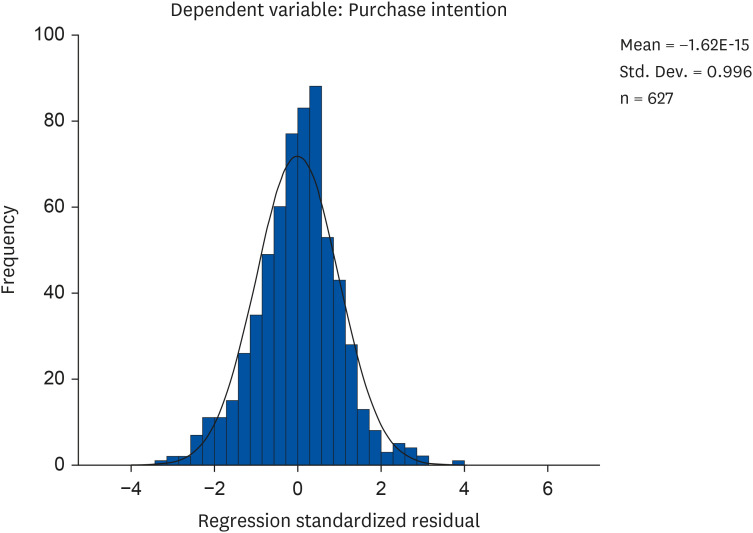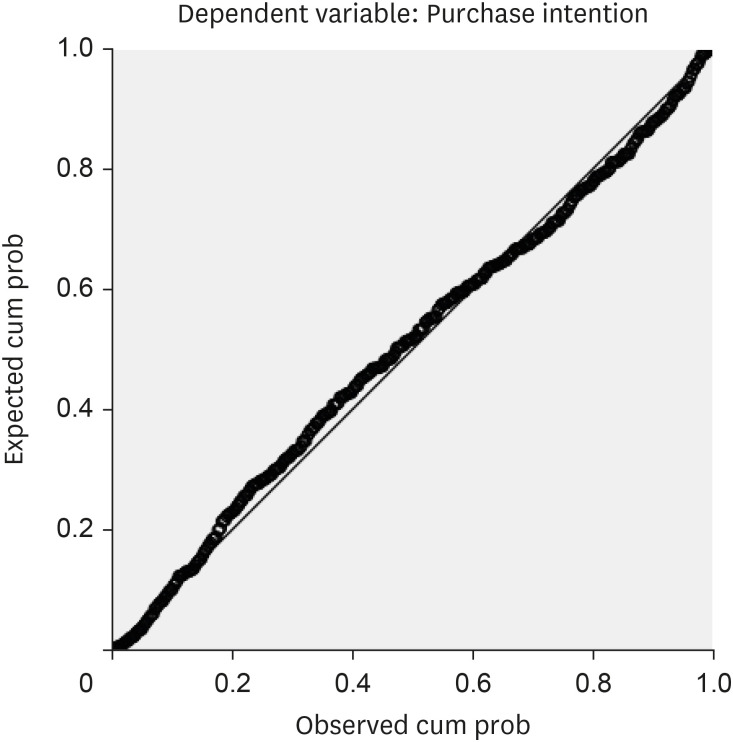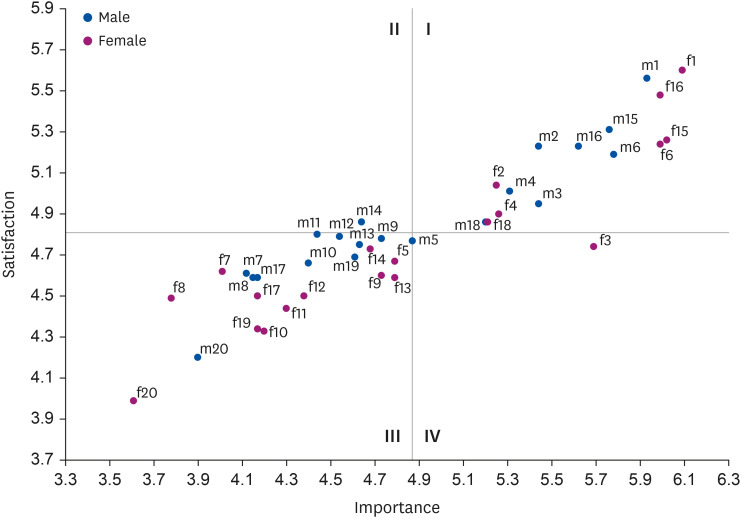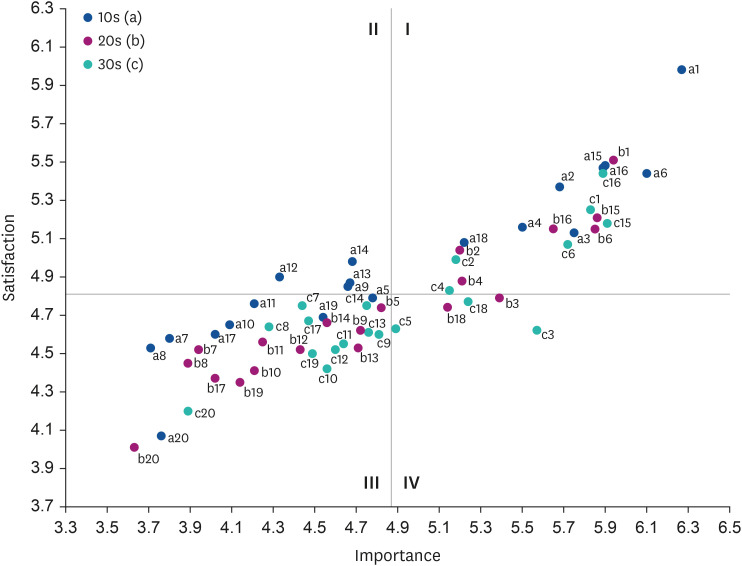Nutr Res Pract.
2024 Aug;18(4):567-585. 10.4162/nrp.2024.18.4.567.
A study on the consumer behavior and attitude toward low-sodium convenience store foods
- Affiliations
-
- 1Department of Nutritional Science and Food Management, Ewha Womans University, Seoul 03760, Korea
- 2Graduate Program in System Health Science and Engineering, Ewha Womans University, Seoul 03760, Korea
- 3College of Science and Industry Convergence, Ewha Womans University, Seoul 03760, Korea
- KMID: 2558494
- DOI: http://doi.org/10.4162/nrp.2024.18.4.567
Abstract
- BACKGROUND/OBJECTIVES
This study aims to explore the potential of convenience stores as platforms for healthy food consumption, including low-sodium options, in response to the increasing trend of meal behaviors at convenience stores and the growing demand for healthy eating.
SUBJECTS/METHODS
In the study, 627 Korean participants aged 10 to 39 were involved. A self-reported questionnaire survey was used and questions were regarding purchase patterns, consumption behaviors, perceptions and selection attributes of convenience store foods, and consumer perception factors for low-sodium options. Data analysis was conducted using SPSS 26.0 (SPSS, Version 26.0 for Windows, SPSS Inc., Chicago, IL, USA).
RESULTS
The study uncovered significant disparities in the consumption behavior and perception of convenience store foods, as well as variations in the importance and satisfaction levels with convenience store food attributes, including consumer perception factors for low-sodium options, based on sex and age. Furthermore, it was observed that awareness of the need for low-sodium options significantly influenced purchase intentions.
CONCLUSION
This study analyzed consumer attitude toward low-sodium convenience store foods to assess the potentiality for promoting healthy eating in convenience stores. These findings indicate the important role that convenience stores can play as platforms for healthy food sales.
Keyword
Figure
Reference
-
1. Huse O, Reeve E, Baker P, Hunt D, Bell C, Peeters A, Backholer K. The nutrition transition, food retail transformations, and policy responses to overnutrition in the East Asia region: a descriptive review. Obes Rev. 2022; 23:e13412. PMID: 34981877.
Article2. Imtiyaz H, Soni P, Yukongdi V. Understanding consumer’s purchase intention and consumption of convenience food in an emerging economy: role of marketing and commercial determinants. J Agric Food Res. 2022; 10:100399.
Article3. Yoon NH, Shon C. Convenience store use and the health of urban adolescents in Seoul, South Korea. Int J Environ Res Public Health. 2020; 17:6486. PMID: 32899954.4. Kaji A, Hashimoto Y, Sakai R, Okada H, Hamaguchi M, Ushigome E, Majima S, Yamazaki M, Fukui M. Frequent usage of convenience stores is associated with low diet quality. Nutrients. 2019; 11:1212. PMID: 31141979.
Article5. Lind PL, Jensen PV, Glümer C, Toft U. The association between accessibility of local convenience stores and unhealthy diet. Eur J Public Health. 2016; 26:634–639. PMID: 26851817.
Article6. Rummo PE, Meyer KA, Boone-Heinonen J, Jacobs DR Jr, Kiefe CI, Lewis CE, Steffen LM, Gordon-Larsen P. Neighborhood availability of convenience stores and diet quality: findings from 20 years of follow-up in the coronary artery risk development in young adults study. Am J Public Health. 2015; 105:e65–e73.
Article7. McKerchar C, Smith M, Gage R, Williman J, Abel G, Lacey C, Ni Mhurchu C, Signal L. Kids in a candy store: an objective analysis of children’s interactions with food in convenience stores. Nutrients. 2020; 12:2143. PMID: 32708485.
Article8. Park SK, Lee JH. Factors influencing the consumption of convenience foods among Korean adolescents: analysis of data from the 15th (2019) Korea Youth Risk Behavior Web-based Survey. J Nutr Health. 2020; 53:255–270.9. Oishi K, Aoki T, Harada T, Tanaka C, Tanaka S, Tanaka H, Fukuda K, Kamikawa Y, Tsuji N, Komura K, et al. Association of neighborhood food environment and physical activity environment with obesity: a large-scale cross-sectional study of fifth-to ninth-grade children in Japan. Inquiry. 2021; 58:469580211055626. PMID: 34763543.10. Zhou S, Cheng Y, Cheng L, Wang D, Li Q, Liu Z, Wang HJ. Association between convenience stores near schools and obesity among school-aged children in Beijing, China. BMC Public Health. 2020; 20:150. PMID: 32005214.
Article11. Powell LM, Auld MC, Chaloupka FJ, O’Malley PM, Johnston LD. Associations between access to food stores and adolescent body mass index. Am J Prev Med. 2007; 33:S301–S307. PMID: 17884578.
Article12. Zhang X, Chen B, Jia P, Han J. Locked on salt? Excessive consumption of high-sodium foods during COVID-19 presents an underappreciated public health risk: a review. Environ Chem Lett. 2021; 19:3583–3595. PMID: 34093102.
Article13. World Health Organization. Guideline: Sodium Intake for Adults and Children. Geneva: World Health Organization;2012.14. Korea Consumer Agency. Investigation of Safety Conditions of Convenience Store Lunch Boxes: Safety Report. Eumseong: Korea Consumer Agency;2021.15. Korea Centers for Disease Control and Prevention. 2021 National health statistics [Internet]. Cheongju: Korea Centers for Disease Control and Prevention;2022. cited 2023 September 8. Available from: https://knhanes.kdca.go.kr/knhanes/sub04/sub04_04_01.do.16. National Institute of Health and Nutrition (JP). The National Health and Nutrition Survey (NHNS) Japan [Internet]. Tokyo: National Institute of Health and Nutrition;2019. cited 2023 September 8. Available from: https://www.nibiohn.go.jp/eiken/kenkounippon21/en/eiyouchousa/.17. Li Y, Zhang P, Wu J, Ma J, Xu J, Zhang X, Luo R, Liu M, Sun Y, Li X, et al. Twenty-four-hour urinary sodium and potassium excretion and their associations with blood pressure among adults in China: baseline survey of action on salt China. Hypertension. 2020; 76:1580–1588. PMID: 32981359.18. Meneton P, Jeunemaitre X, de Wardener HE, MacGregor GA. Links between dietary salt intake, renal salt handling, blood pressure, and cardiovascular diseases. Physiol Rev. 2005; 85:679–715. PMID: 15788708.
Article19. Bibbins-Domingo K, Chertow GM, Coxson PG, Moran A, Lightwood JM, Pletcher MJ, Goldman L. Projected effect of dietary salt reductions on future cardiovascular disease. N Engl J Med. 2010; 362:590–599. PMID: 20089957.
Article20. Nagata C, Takatsuka N, Shimizu N, Shimizu H. Sodium intake and risk of death from stroke in Japanese men and women. Stroke. 2004; 35:1543–1547. PMID: 15143292.
Article21. Enes CC, de Camargo CM, Justino MIC. Ultra-processed food consumption and obesity in adolescents. Rev Nutr. 2019; 32:e180170.
Article22. Onita BM, Azeredo CM, Jaime PC, Levy RB, Rauber F. Eating context and its association with ultra-processed food consumption by British children. Appetite. 2021; 157:105007. PMID: 33075442.23. Costa CS, Rauber F, Leffa PS, Sangalli CN, Campagnolo PD, Vitolo MR. Ultra-processed food consumption and its effects on anthropometric and glucose profile: a longitudinal study during childhood. Nutr Metab Cardiovasc Dis. 2019; 29:177–184. PMID: 30660687.
Article24. Srour B, Fezeu LK, Kesse-Guyot E, Allès B, Debras C, Druesne-Pecollo N, Chazelas E, Deschasaux M, Hercberg S, Galan P, et al. Ultraprocessed food consumption and risk of type 2 diabetes among participants of the NutriNet-Santé prospective cohort. JAMA Intern Med. 2020; 180:283–291. PMID: 31841598.
Article25. Fiolet T, Srour B, Sellem L, Kesse-Guyot E, Allès B, Méjean C, Deschasaux M, Fassier P, Latino-Martel P, Beslay M, et al. Consumption of ultra-processed foods and cancer risk: results from NutriNet-Santé prospective cohort. BMJ. 2018; 360:k322. PMID: 29444771.
Article26. Pae M. Dietary habits and perception toward food additives according to the frequency of consumption of convenience food at convenience stores among university students in Cheongju. Korean J Community Nutr. 2016; 21:140–151.
Article27. Kim MS, Sohn DJ. [K-food goes global] Viral frozen ‘Kimbap’ on a roll in the U.S. [Internet]. Seoul: JoongAng Daily Co., Ltd.;2023. cited 2023 September 8. Available from: https://koreajoongangdaily.joins.com/news/2023-08-23/business/industry/KFOOD-GOES-GLOBAL-Viral-frozen-Gimbap-on-a-roll-in-the-US/1853406.28. Korea Consumer Agency. Quality Test Report of Convenience Store Triangular Gimbap: Test Result Report. Eumseong: Korea Consumer Agency;2013.29. Marshall D. Convenience stores and well-being of young Japanese consumers. Int J Retail Distrib Manag. 2019; 47:590–604.
Article30. Glanz K, Basil M, Maibach E, Goldberg J, Snyder D. Why Americans eat what they do: taste, nutrition, cost, convenience, and weight control concerns as influences on food consumption. J Am Diet Assoc. 1998; 98:1118–1126. PMID: 9787717.31. Dono J, Ettridge K, Wakefield M, Pettigrew S, Coveney J, Roder D, Durkin S, Wittert G, Martin J, Miller C. Nothing beats taste or convenience: a national survey of where and why people buy sugary drinks in Australia. Aust N Z J Public Health. 2020; 44:291–294. PMID: 32510712.
Article32. Martinez-Perez N, Telleria-Aramburu N, Insúa P, Hernández I, Telletxea S, Ansotegui L, Rebato E, Basabe N, de Pancorbo MM, Rocandio A, et al. On-campus food purchase behaviors, choice determinants, and opinions on food availability in a Spanish university community. Nutrition. 2022; 103-104:111789. PMID: 35964438.
Article33. Wills W, Danesi G, Kapetanaki AB, Hamilton L. Socio-economic factors, the food environment and lunchtime food purchasing by young people at secondary school. Int J Environ Res Public Health. 2019; 16:1605. PMID: 31071922.34. Lee JH, Lee JJ. Changes in retail stores in South Korea and Japan: centered on convenience stores in both countries. Jpn Cult Stud. 2018; 67:277–292.35. Yeo GE, Lee KW, Lee EY, Jeon YW, Lee JO, Oh JE, Cho MS. Selection attributes of non-timber forest products and consumer attitudes among food-related lifestyle segmentation. J Korean Soc Food Sci Nutr. 2020; 49:1152–1160.
Article36. Wong SL, Hsu CC, Chen HS. To buy or not to buy? Consumer attitudes and purchase intentions for suboptimal food. Int J Environ Res Public Health. 2018; 15:1431. PMID: 29986474.
Article37. Ryu MH. Undergraduate consumers’ information needs according to purchase intention toward convenience store private brand foods. Fam Environ Res. 2013; 51:623–635.
Article38. Kim TK. T test as a parametric statistic. Korean J Anesthesiol. 2015; 68:540–546. PMID: 26634076.39. Yang CC. Improvement actions based on the customers’ satisfaction survey. Total Qual Manage Bus Excell. 2003; 14:919–930.
Article40. Chen S, Shan LC, Tao W, Lu T, Regan Á, Han H, Guo L, Deng T, Wall P. A survey of Chinese consumers’ knowledge, beliefs and behavioural intentions regarding salt intake and salt reduction. Public Health Nutr. 2020; 23:1450–1459. PMID: 31928552.
Article41. Ji Y, Han J. Sustainable home meal replacement (HMR) consumption in Korea: exploring service strategies using a modified importance–performance analysis. Foods. 2022; 11:889. PMID: 35327311.
Article42. Liu YY, Chen SH, Zhang JX. Applying importance–satisfaction model to evaluate customer satisfaction: an empirical study of foodpanda. Sustainability (Basel). 2021; 13:10985.
Article43. Korea Rural Economic Institute. 2022 Processed food consumer attitude survey [Internet]. Naju: Korea Rural Economic Institute;2023. cited 2023 May 2. Available from: http://www.krei.re.kr/foodInfo/selectBbsNttView.do?key=749&bbsNo=434&nttNo=159223&searchCtgry=&searchCnd=all&searchKrwd=&pageIndex=1&integrDeptCode=.44. Ministry of Agriculture, Food and Rural Affairs (KR). Korea Agro-Fisheries Trade Corporation. 2019 Report on the current status of the processed food market for convenience and processed foods [Internet]. Naju: Korea Agro-Fisheries Trade Corporation;2019. cited 2023 May 2. Available from: https://www.atfis.or.kr/home/board/FB0027.do?act=read&bpoId=3260&bcaId=0&pageIndex=1.45. National Food Safety Information Service (KR). A survey on the nutritional components of home meal replacements sold in convenience stores [Internet]. Cheongju: National Food Safety Information Service;2020. cited 2023 May 2. Available from: https://www.mfds.go.kr/brd/m_99/view.do?seq=44833.46. Lee SK, Kim MK. Relationship of sodium intake with obesity among Korean children and adolescents: Korea National Health and Nutrition Examination Survey. Br J Nutr. 2016; 115:834–841. PMID: 26759221.47. Zhu H, Pollock NK, Kotak I, Gutin B, Wang X, Bhagatwala J, Parikh S, Harshfield GA, Dong Y. Dietary sodium, adiposity, and inflammation in healthy adolescents. Pediatrics. 2014; 133:e635–e642. PMID: 24488738.
Article48. Simons-Morton DG, Obarzanek E. Diet and blood pressure in children and adolescents. Pediatr Nephrol. 1997; 11:244–249. PMID: 9090675.
Article49. Van Boxstael S, Devlieghere F, Berkvens D, Vermeulen A, Uyttendaele M. Understanding and attitude regarding the shelf life labels and dates on pre-packed food products by Belgian consumers. Food Control. 2014; 37:85–92.
Article50. Okumus B, Dedeoğlu BB, Shi F. Gender and generation as antecedents of food neophobia and food neophilia. Tour Manag Perspect. 2021; 37:100773.
Article51. Neumark-Sztainer D, Story M, Perry C, Casey MA. Factors influencing food choices of adolescents: findings from focus-group discussions with adolescents. J Am Diet Assoc. 1999; 99:929–937. PMID: 10450307.52. Gerend MA. Does calorie information promote lower calorie fast food choices among college students? J Adolesc Health. 2009; 44:84–86. PMID: 19101463.
Article53. Mohr B, Dolgopolova I, Roosen J. The influence of sex and self-control on the efficacy of nudges in lowering the energy content of food during a fast food order. Appetite. 2019; 141:104314. PMID: 31181248.
Article54. McKenzie B, Santos JA, Trieu K, Thout SR, Johnson C, Arcand J, Webster J, McLean R. The science of salt: a focused review on salt-related knowledge, attitudes and behaviors, and gender differences. J Clin Hypertens (Greenwich). 2018; 20:850–866. PMID: 29722131.
Article55. Iaccarino Idelson P, D’Elia L, Cairella G, Sabino P, Scalfi L, Fabbri A, Galletti F, Garbagnati F, Lionetti L, Paolella G, et al. Salt and health: survey on knowledge and salt intake related behaviour in Italy. Nutrients. 2020; 12:279. PMID: 31973152.
Article56. Wardle J, Haase AM, Steptoe A, Nillapun M, Jonwutiwes K, Bellisle F. Gender differences in food choice: the contribution of health beliefs and dieting. Ann Behav Med. 2004; 27:107–116. PMID: 15053018.57. Driskell JA, Meckna BR, Scales NE. Differences exist in the eating habits of university men and women at fast-food restaurants. Nutr Res. 2006; 26:524–530.
Article58. Qazzafi S. Consumer buying decision process toward products. Int J Sci Res Eng Dev. 2019; 2:130–134.59. Lim J, Moon S, Yeo GE, Kim ES, Kim Y, Oh JE. A study on a perception and promotion plan for employees to increase the consumption of low-sodium foods using importance performance analysis (IPA) - focused on ready-to-eat foods (samgak-kimbap, riceballs) -. J Korean Soc Food Cult. 2023; 38:129–142.
- Full Text Links
- Actions
-
Cited
- CITED
-
- Close
- Share
- Similar articles
-
- The frequency of convenience food consumption and attitude of sodium and sugar reduction among middle and high school students in Seoul: a descriptive study
- Factors influencing the consumption of convenience foods among Korean adolescents: analysis of data from the 15th (2019) Korea Youth Risk Behavior Web-based Survey
- A study on the relationship between purchases of meal kits and home meal replacements
- Agrifood consumer competency and organic food purchase intentions according to food-related lifestyle: based on data the 2019 Consumer Behavior Survey for Food
- Evaluation of Nutritional Quality of Convenience Store Meal Boxes according to Store Company and Meal Price





